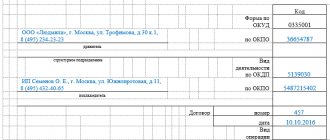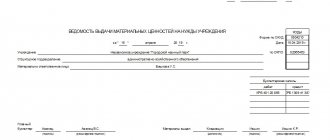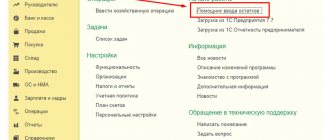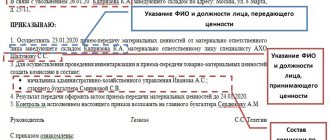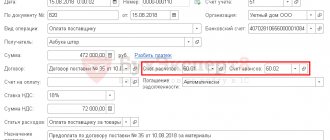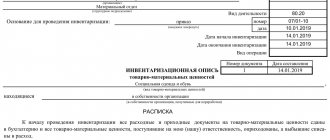One of the common mistakes of organizations is the lack of valuation reserves in accounting. Believing that there is no basis for the formation of such reserves, the organization ignores the requirements for drawing up financial statements, which can lead to its unreliability. Let's analyze the main points that need to be taken into account when creating a reserve for reducing the value of material assets.
First of all, let us recall that valuation reserves include reserves for doubtful debts, for a decrease in the value of material assets, and for the depreciation of financial investments. In accordance with the Accounting Regulations “Changes in estimated values”, approved. by order of the Ministry of Finance of the Russian Federation dated October 6, 2008 No. 106n (hereinafter referred to as PBU 21/2008), the amount of these reserves is an estimated value. And changes in estimated reserves must be reflected in accounting prospectively, i.e. by inclusion in other income or other expenses (clause 3, clause 4 of PBU 21/2008).
AUDIT OF ACCOUNTING REPORTS
Basic Concepts
Reserves are needed to ensure the reliability of asset valuations. Let's consider the criteria for creating a reserve for valuables:
- The value of valuables has actually decreased. This may be due to the obsolescence of the object, loss of consumer qualities, or a decrease in value by similar values on the market.
- Material assets do not belong to the consolidated accounting groups listed in paragraph 20 of the instructions of the Ministry of Finance. For example, they are not groups of basic or auxiliary materials, finished goods, or segment inventories.
- There are reasons to accurately determine the cost. For example, the cost can be determined on the basis of internal documentation, external information, and company accounting registers.
The procedure for creating a reserve is specified in clause PBU 5/01.
EXAMPLE No. 2
The organization purchased 200 m of fabric at a price of 50 rubles per 1 m for sewing garments. There were 150 m of fabric left in the warehouse. At the end of the year, due to changes in market conditions, fabric can be purchased at a price of 40 rubles per 1 m.
Let's assume that 50 m of fabric were spent on sewing 10 pieces of products. The actual cost of one piece of the finished product is 300 rubles. As of the reporting date, the current market price of the finished product is 400 rubles.
In this case, a reserve for reducing the value of inventories is not formed.
Provision for impairment of value
Valuables whose price has decreased must be recorded in the balance sheet at the end of the year. Reflection is carried out at the current market value. In this case, the actual wear and tear of the valuables is taken into account. The basis of the provision must be consistent with the prudence principle. The essence of this principle is that recognition of expenses rather than income is paramount. Hidden reserves cannot be created. The procedure for creating a reserve for reducing the value of valuables:
- Valuable balances are tested for signs of depreciation. These signs can be internal and external. Local signs: unused valuables that have lost their consumer properties, the presence of damage on them. External signs: a decrease in market prices for similar values, technological progress that makes objects irrelevant. Testing is carried out as part of the inventory. It is carried out at the end of the reporting year. If the market value of the property is greater than the actual value, there is no need to create a reserve.
- It is required to establish the market value of the assets, on the basis of which signs of depreciation were detected. When determining the cost, you can use the prices indicated in official sources. It is also possible to use data obtained from independent specialists. For example, these could be experts. The validity of the calculation of market value must be confirmed by documents.
- The current market value is compared with the cost of the assets. Cost refers to the data contained in accounting. If the cost exceeds the market value, a reserve is created for the difference.
- A reserve is being formed. It needs to be created for each value. The formation of reserves for enlarged groups is not allowed. For example, building materials cannot be taken as a unit. However, it is possible to combine units of value if they are homogeneous. For example, you can combine equipment with the same characteristics.
Each of the stages of cost reduction is mandatory.
Determining the current value of assets
Market value is determined based on the following factors:
- Statistical information published by Rosgosstat.
- Information published by the media.
- Methods of analytical calculations.
- Data provided by experts and appraisers.
IMPORTANT! The method for determining market value must be recorded in the accounting policy.
Determining the size of the reserve
The volume of the reserve is established for each item of value. The formula for calculations looks like this:
Book value – current market value * number of values
The current market value refers to the amount that can be obtained from the sale of valuables at the moment.
Results
Accounting for reserves for impairment of inventories is carried out in accordance with the standards outlined in regulatory legal acts in the field of accounting. At the same time, many aspects of the procedure for creating and accounting for such reserves are not clearly regulated by the current provisions. Therefore, the enterprise should formulate the applicable nuances of the formation of reserves and consolidate them in the accounting policy.
Find out about the disclosure of data on inventories in IFRS here: “IFRS No. 2 Inventories - features of application and purposes.”
You can find more complete information on the topic in ConsultantPlus. Free trial access to the system for 2 days.
Adjustment of reserve for reduction in value
So, the reserve was founded. However, it can be changed if the following circumstances are present:
- Write-off of the reserve. Performed in the event that valuables are written off from the balance sheet due to their direction for production, sale, or transfer free of charge. Write-offs are made to other income.
- Creating an adjustment. Performed if the value of valuables has increased. The difference between actual and market value decreases. The reserve must be reduced.
If at the end of the reporting period the value of objects is reduced, but they are not written off, the reserve is allocated to the next period.
Why is it more reliable and convenient to work with us than with regular employees?
- You work with a team, not just one employee. The work of each specialist is checked, and solutions are found quickly and efficiently.
- Our problems don't become yours. Forget about organizing a place for an employee, paying sick leave and vacations. If someone from our team gets sick, you won’t notice it - another specialist will immediately replace him!
- We have experts of different profiles. Lawyers, 1C specialists - we take a comprehensive approach to accounting and can optimize the work of an entire department.
Call the phone number listed on the website or fill out the feedback form so that we can guide you on the exact cost, choose the best solution and tell you how to start cooperation!
Accounting
To record information about reserves for depreciation in value, account 14 “Reserve for depreciation of value on assets” is used. The formation of the reserve is recorded in accounting as follows:
- DT91 KT14. A reserve has been created.
- DT14 KT91. Restoring the reserve amount in the process of writing off valuables.
DT14 KT91 – a record that is relevant when the market value increases. It is used at the end of the reporting period if the reserve has not been used.
Examples of accounting entries
When working with reserves to reduce the value of valuables, these following accounting entries are used:
- DT 91 (subaccount “Other expenses”) KT14. A reserve has been formed to reduce the cost.
- DT99 (sub-account “Permanent tax obligations”) KT68. Fixation of tax obligations.
As the products are used, the reserve is restored:
- DT62 KT90. Recognition of revenue from sales of products.
- DT90 (sub-account “VAT”) KT 68 (sub-account “VAT”). VAT on proceeds from the sale of products.
- DT90 KT41. Write-off of the cost of valuables.
- DT14 CT 91 (subaccount “Other income”). Write-off of a previously formed reserve to reduce the value of valuables.
- DT68 KT99 (sub-account “Tax obligations”).
The main account for a decrease in value is active-passive account 14. The formation of a reserve is recorded by credit, and the restoration or increase in value is recorded by debit.
Primary documents
Each accounting entry is based on primary documentation. The supporting documents confirm the indicated amounts and transactions. Let's look at an approximate list of primary items:
- Leader's order.
- Certificate from the accounting department.
- Various payment documents.
If information from primary documents contradicts accounting data, regulatory authorities will have questions.
Regulatory acts
In the process of regulating management activities for reserves, various types and forms of documentation are used. It is divided into several levels.
- Decrees, orders adopted by the President of the Russian Federation, as well as regional government bodies.
- Local regulations of the enterprise.
- Methodical instructions.
- Accounting documents (invoices, delivery notes, accounting certificates, etc.).
- Other forms of documentation that are relevant in the process of accounting activities.
Thus, account 14 in accounting is relevant and is used quite often. The creation of reserves is necessary in a large number of practical situations, since not only the convenience of accounting operations, but also the transparency of transactions depends on it.
It is necessary to achieve competent preparation of transactions in all directions and signing of correct and rational amounts for them, since the fact of fulfillment of obligations depends on them.
Tax accounting
Chapter 25 of the Tax Code of the Russian Federation does not imply a reduction in taxable profit. That is, a reserve that reduces accounting profit but is not taken into account when creating taxable profit is considered a permanent difference. In the period in which the permanent difference was formed, a tax liability arises. This is a tax that provokes an increase in tax payments. Let's look at transactions related to taxation:
- DT99 (sub-account “Tax obligations”) KT68.
- DT68 KT99 (required to create a subaccount). The posting is used when restoring the reserve.
Both tax and accounting must comply with regulations.
Subaccounts
When performing a high-quality analysis of material reserves and opening account 14, the accountant needs to rely only on documented cases of price changes (an important component is the state of the market for the settlement period, which is also taken into account), and also correctly classify material funds into sub-accounts. The need to create specific sub-accounts for account 14 is not regulated by law - the organization’s management creates them independently, in accordance with the specifics of the individual working chart of accounts.
Reflection in the balance sheet when preparing annual individual financial statements
Failure to create a reserve affects the quality and reliability of reporting. In the absence of a reserve, material assets are reflected in the statements at the purchase price, and not at the actual valuation. This, in turn, affects indicators such as enterprise profitability and earnings per share. Deliberate non-creation is a unique way of artificially inflating the value of assets on the balance sheet and regulating financial results.
>> Full text is available to subscribers. Get access. >>
Natalya Litkova, economist, expert of the magazine “Chief Accountant”


